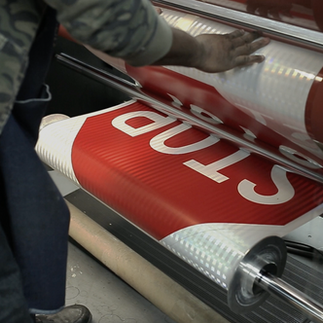From printing on metal plates and using stones to digitally printing on reflective sheeting with high-solvent latex inks: how did we get here? Large-scale digital printing has only been available in the last few decades, and we’re proud to be one of the few cutting-edge industries to utilize this technology. We’ve gone into detail about retroreflectivity, our retroreflective sheeting, and our wide-format inkjet printers—it’s time for a brief history of digital printing!

China developed the very first form of printing using woodblocks in 200AD—a form of printing that now is often only used in art. In 1041, Bi Sheng created moveable type—characters were carved out of clay (later wood and metal) and arranged to print out a message. Moveable type meant that the characters could be reused and rearranged for messaging, speeding up the printing process. Johan Gutenberg invented the first printing press in 1440—nearly 300 years later, and it was this invention that hugely contributed to the evolution of print since then.
A century later, etching was used to decorate armor: designs were carved into metal plates and used to print, which Daniel Hopfer thought to utilize in everyday printmaking in 1515. This process involved using acid or chemicals to carve out the metal (a similar process to how we chemically treat our aluminum—see our latest video on that!). This naturally led to lithography, a form of printing that uses water’s and oil’s repelling relationship to set the ink.
The rotary press, 1843, applied the designs/carving to cylinders. This allowed paper to be fed through continuously, maximizing space and further speeding up the printing process.
However, it was offset printing, developed in 1875, that marks our modern era of printing. This method transfers ink to a plate, then to a rubber blanket, before printing onto (usually) paper surface. Offset printing is the form of printing used today for large-format printing, like magazines and books. Though China invented screen-printing between 960 - 1279AD, it wasn’t until silk became more widely available in 1910 that this printing method took off—also being used today for t-shirts, posters, and sometimes even signage.
Finally, we get to inkjet printers, first invented in 1951, where prints were made by literally spraying ink through a jet. In 1969, this evolved into laser printing, where powder ink and electrical charges were used to transfer images onto paper.
Let's travel backward in time just a little bit to 1946 when Poland gave birth to Benny Landa, the son of a man who created a camera using pulleys and bike parts that printed images onto photographic paper—removing the need for film. This method was incremental in developing Benny Landa’s later discoveries. In 1971, Landa developed ElectroInk, a photocopying ink that would no longer need powdered ink, speeding up the photocopying process 10x’s, meaning 100-150 sheets a minute could be printed—and creating the fastest copy machine that had existed to date.
He founded Indigo Digital Printing in 1977 after discovering that the ink for the photocopier, ElectroInk, could also be used in printers. ElectroInk utilizes minuscule particles suspended in imaging oil called Isopar. The particles form a thin plastic layer on the printed surface.
Using this ink, in 1993, Landa launched the world’s first digital color printers.
Slightly prior to this, most people used what was called “prepress” printers, a form of inkjet printer that printed proofs versus final products. After the first digital print was released in 1989, it was Graham Nash, from Crosby, Stills, and Nash, who purchased and modified an Iris 3047 printer for inkjet printing. He then opened Nash Editions, one of the world’s top fine art photographic printmaking houses, which is recognized by the Smithsonian Institution for its role in the invention of digital fine art printing.

Hewlett Packard invested in Indigo in 2000 and in 2001, acquired the remaining shares. Benny Landa is why HP is one of the leading producers of innovative digital printers to this day! Benny Landa continues to develop and advance his digital printers and has become a world-renowned entrepreneur and philanthropist. Graham Nash’s Iris 3
047 is now in the Smithsonian. Though already a successful musician, he also continues to pursue digital imaging.
As for us—you can check out this video to learn about how we use the newest innovative technology in digital printing and high-solvent latex inks to create the longest-lasting interstate and road signs in the USA!
















